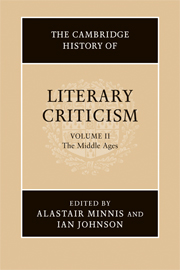Book contents
- Frontmatter
- Introduction
- I THE LIBERAL ARTS AND THE ARTS OF LATIN TEXTUALITY
- II THE STUDY OF CLASSICAL AUTHORS
- III TEXTUAL PSYCHOLOGIES: IMAGINATION, MEMORY, PLEASURE
- 7 Medieval imagination and memory
- 8 The profits of pleasure
- IV VERNACULAR CRITICAL TRADITIONS: THE EARLY MIDDLE AGES
- V VERNACULAR CRITICAL TRADITIONS: THE LATE MIDDLE AGES
- VI LATIN AND VERNACULAR IN ITALIAN LITERARY THEORY
- VII BYZANTINE LITERARY THEORY AND CRITICISM
- Bibliography
- Index
- References
7 - Medieval imagination and memory
from III - TEXTUAL PSYCHOLOGIES: IMAGINATION, MEMORY, PLEASURE
Published online by Cambridge University Press: 28 March 2008
- Frontmatter
- Introduction
- I THE LIBERAL ARTS AND THE ARTS OF LATIN TEXTUALITY
- II THE STUDY OF CLASSICAL AUTHORS
- III TEXTUAL PSYCHOLOGIES: IMAGINATION, MEMORY, PLEASURE
- 7 Medieval imagination and memory
- 8 The profits of pleasure
- IV VERNACULAR CRITICAL TRADITIONS: THE EARLY MIDDLE AGES
- V VERNACULAR CRITICAL TRADITIONS: THE LATE MIDDLE AGES
- VI LATIN AND VERNACULAR IN ITALIAN LITERARY THEORY
- VII BYZANTINE LITERARY THEORY AND CRITICISM
- Bibliography
- Index
- References
Summary
In his Biographia literaria (written 1815, published 1817), Samuel Taylor Coleridge gave his theory of the literary imagination its fullest exposition. The ideal poet, he declares, ‘brings the whole soul of man into activity, with the subordination of its faculties to each other, according to their relative worth and dignity. He diffuses a tone and spirit of unity that blends and (as it were) fuses, each into each, by that synthetic [i.e. synthesising] and magic power to which we have exclusively appropriated the name of imagination’ (pp. 173–4). This connection between imagination and the value of creative genius persists in modern use of the term ‘imagination’ and especially in use of the adjectival form ‘imaginative’. But it is the tradition which Coleridge was breaking away from, the empiricist-materialist view of literary imagination as memory images brought together by association, which has more in common with medieval views on the subject. Moreover, while Coleridge was interested in the psychology of composition, medieval thinkers were more interested in the psychology of audience-response, images being common property of author and audience, having a life beyond the psyches of their creators.
Standard late-medieval theory of imagination is cogently summarised in the encyclopaedic De proprietatibus rerum of Bartholomew the Englishman (compiled before 1250), which was translated into several European vernaculars. The brain, he explains (following a description which goes back to Galen), is divided into three small cells, the first being ymaginatiua, where things which the exterior senses perceive ‘are ordered and put together’; the middle chamber is called logica, where the power of estimation is master; and the third and last is memorativa, the power of remembrance, by which things which are apprehended and known by imagination and reason are held and preserved in the treasury of memory (3.10).
- Type
- Chapter
- Information
- The Cambridge History of Literary Criticism , pp. 237 - 274Publisher: Cambridge University PressPrint publication year: 2005
References
- 6
- Cited by



